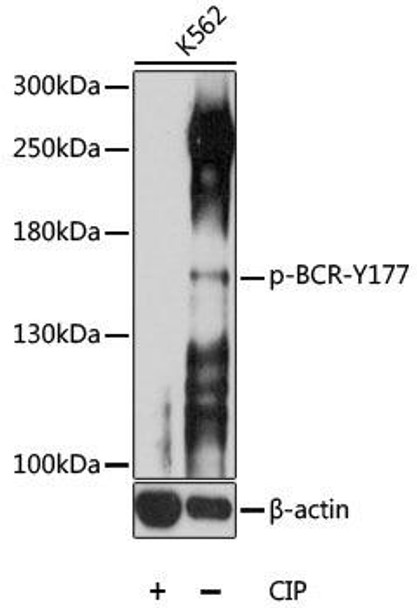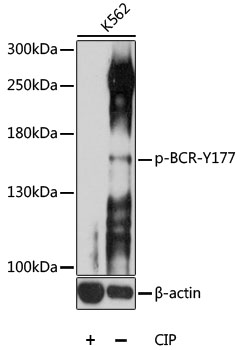Cell Biology Antibodies 16
Anti-Phospho-BCR-Y177 Antibody (CABP0606)
- SKU:
- CABP0606
- Product Type:
- Antibody
- Applications:
- WB
- Reactivity:
- Human
- Reactivity:
- Mouse
- Host Species:
- Rabbit
- Isotype:
- IgG
- Research Area:
- Cell Biology
Description
| Antibody Name: | Anti-Phospho-BCR-Y177 Antibody |
| Antibody SKU: | CABP0606 |
| Antibody Size: | 20uL, 50uL, 100uL |
| Application: | WB |
| Reactivity: | Human, Mouse |
| Host Species: | Rabbit |
| Immunogen: | A synthetic phosphorylated peptide around Y177 of human BCR (NP_004318.3). |
| Application: | WB |
| Recommended Dilution: | WB 1:500 - 1:2000 |
| Reactivity: | Human, Mouse |
| Positive Samples: | K562 |
| Immunogen: | A synthetic phosphorylated peptide around Y177 of human BCR (NP_004318.3). |
| Purification Method: | Affinity purification |
| Storage Buffer: | Store at -20°C. Avoid freeze / thaw cycles. Buffer: PBS with 0.02% sodium azide, 50% glycerol, pH7.3. |
| Isotype: | IgG |
| Sequence: | PFYV N |
| Gene ID: | 613 |
| Uniprot: | P11274 |
| Cellular Location: | Cell junction, postsynaptic cell membrane, postsynaptic density, synapse |
| Calculated MW: | 137kDa/142kDa |
| Observed MW: | 160kDa |
| Synonyms: | BCR, ALL, BCR1, CML, D22S11, D22S662, PHL |
| Background: | A reciprocal translocation between chromosomes 22 and 9 produces the Philadelphia chromosome, which is often found in patients with chronic myelogenous leukemia. The chromosome 22 breakpoint for this translocation is located within the BCR gene. The translocation produces a fusion protein which is encoded by sequence from both BCR and ABL, the gene at the chromosome 9 breakpoint. Although the BCR-ABL fusion protein has been extensively studied, the function of the normal BCR gene product is not clear. The protein has serine/threonine kinase activity and is a GTPase-activating protein for p21rac. Two transcript variants encoding different isoforms have been found for this gene. |
| UniProt Protein Function: | Bcr: a protein with serine/threonine protein kinase activity and is a GTPase-activating protein (GAP) for RAC1 and CDC42. The amino-terminal region of Bcr contains an oligomerization domain, a serine/threonine kinase domain and a region that binds SH2 domains. The middle of the protein has a PH domain and a region of sequence similarity to the guanine nucleotide exchange factors for the Rho family of GTP binding proteins. The carboxy-terminal region promotes the exchange of RAC or CDC42-bound GDP by GTP, thereby activating them. A breakpoint cluster region protein that participates in a t(9;22)(q34;q11) chromosomal translocation that produces a BCR-ABL oncogene responsible for chronic myeloid leukemia (CML), acute myeloid leukemia (AML) and acute lymphoblastic leukemia (ALL). The function of wild type Bcr in cells remains unclear. PDGF receptor may use Bcr as a downstream signaling mediator. Tyr177 of human Bcr, phosphorylated in the Bcr-Abl fusion protein, provides a docking site for Gab2 and GRB2, and is important in the transforming activity of Bcr-Abl. Sequence variants of the Bcr protein may be associated with bipolar disorder. Two alternatively spliced isoforms of the human protein have been reported. |
| UniProt Protein Details: | Protein type:Kinase, protein; GAPs; Oncoprotein; GEFs, Rac/Rho; Protein kinase, atypical; Protein kinase, Ser/Thr (non-receptor); EC 2.7.11.1; GAPs, Rac/Rho; ATYPICAL group; BCR family Chromosomal Location of Human Ortholog: 22q11.23 Cellular Component: postsynaptic membrane; protein complex; membrane; postsynaptic density; cytosol; cell junction Molecular Function:protein serine/threonine kinase activity; protein binding; Rho guanyl-nucleotide exchange factor activity; enzyme binding; protein-tyrosine kinase activity; kinase activity; ATP binding; GTPase activator activity Biological Process: inner ear morphogenesis; peptidyl-tyrosine phosphorylation; regulation of cell cycle; protein amino acid autophosphorylation; platelet-derived growth factor receptor signaling pathway; response to lipopolysaccharide; signal transduction; protein amino acid phosphorylation; regulation of small GTPase mediated signal transduction; negative regulation of neutrophil degranulation; negative regulation of inflammatory response; small GTPase mediated signal transduction; positive regulation of phagocytosis; brain development; neuromuscular process controlling balance; actin cytoskeleton organization and biogenesis; negative regulation of cell migration Disease: Leukemia, Acute Lymphoblastic; Leukemia, Chronic Myeloid |
| NCBI Summary: | A reciprocal translocation between chromosomes 22 and 9 produces the Philadelphia chromosome, which is often found in patients with chronic myelogenous leukemia. The chromosome 22 breakpoint for this translocation is located within the BCR gene. The translocation produces a fusion protein which is encoded by sequence from both BCR and ABL, the gene at the chromosome 9 breakpoint. Although the BCR-ABL fusion protein has been extensively studied, the function of the normal BCR gene product is not clear. The protein has serine/threonine kinase activity and is a GTPase-activating protein for p21rac. Two transcript variants encoding different isoforms have been found for this gene. [provided by RefSeq, Jul 2008] |
| UniProt Code: | P11274 |
| NCBI GenInfo Identifier: | 143811366 |
| NCBI Gene ID: | 613 |
| NCBI Accession: | P11274.2 |
| UniProt Secondary Accession: | P11274,P78501, Q12842, Q4LE80, Q6NZI3, |
| UniProt Related Accession: | P11274 |
| Molecular Weight: | 1271 |
| NCBI Full Name: | Breakpoint cluster region protein |
| NCBI Synonym Full Names: | breakpoint cluster region |
| NCBI Official Symbol: | BCR |
| NCBI Official Synonym Symbols: | ALL; CML; PHL; BCR1; D22S11; D22S662 |
| NCBI Protein Information: | breakpoint cluster region protein; BCR/FGFR1 chimera protein; FGFR1/BCR chimera protein; renal carcinoma antigen NY-REN-26 |
| UniProt Protein Name: | Breakpoint cluster region protein |
| UniProt Synonym Protein Names: | Renal carcinoma antigen NY-REN-26 |
| Protein Family: | Bicyclomycin resistance protein |
| UniProt Gene Name: | BCR |
| UniProt Entry Name: | BCR_HUMAN |







